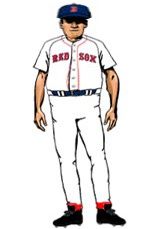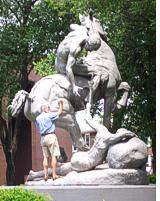
Monthly Archives: July 2014
The Perfect Game
I attended an Inclusive League baseball game on Saturday.
Because all North Puffin children are equally good players, tall and strong, the kids from 6-17 all play hardball together in Inclusive League games. Baseball is a great game, especially here where our League team started up just a couple of years ago. The kids have uniforms, thanks to a Town grant, and a new regulation field next to the hockey rink.
I don’t usually go to games or even watch baseball on TV but I like the game. My dad and I listened to Birds games when we were on the boat. I even attended a Diamondbacks game a couple of years ago. I loved the Ken Burns series but I had mostly stopped watching games back when my friend Jon Matlack was pitching for the Mets. He won a lot of games, but he never won any when I watched. Since pro ball is steeped in superstition, I quit watching and he started winning again. You’re welcome, Jon. Still, Google delivered 1,080,000 results about “baseball musings” in .34 seconds.
 We were there because Bobby, my friend Lido “Lee” Bruhl’s grandson, was starting in his first game as shortstop for the North Puffin Red Sox which is named for the Boston team. There are no Yankees fans in North Puffin.
We were there because Bobby, my friend Lido “Lee” Bruhl’s grandson, was starting in his first game as shortstop for the North Puffin Red Sox which is named for the Boston team. There are no Yankees fans in North Puffin.
Bobby is a great kid but he’s not a very good athlete. He is a little overweight and a little under-coordinated and is often not quite sure how his feet fit. Pretty much the same as 90% of the kids I know.
His mom is an elementary school educator and knows that Bobby’s self-esteem is his armor against the challenges of the world and she knows, absolutely knows that the way to improve his self-esteem is to praise his every activity.
“I teach compassion. Feeling good about yourself is crucial to every other facet of life,” she said.
Bobby had four at bats. He whiffed all three times his first time at the plate.
“Good job, Bobby,” his mom called from the fence line.
Second at bat. He got just little piece of the ball almost by accident and sent a little dribbler back toward the mound. Bobby isn’t a very fast runner and was maybe half way down the base line when the pitcher drilled the ball over to first.
“Great job, Bobby,” his mom called from the fence line.
Third at bat. Bobby asked me not to write about that one.
“You’re doing great, Bobby,” his mom called from the fence line.
Fourth at bat.
The first pitch kind of meandered toward the plate. Swing and a miss. Strike one.
The second throw got away from the pitcher and was high and outside. Ball one.
The third pitch really got away and was high and way outside. The opponents had a terrific catcher. Ball two.
Fourth pitch. Fastball right down the middle. Strike two.
Bobby has trouble with fast balls. Inclusive League pitchers aren’t supposed to throw curves; parents of young pitchers have decried curveballs because contorting elbows that way strains the young joint more than arms can handle. It turns out that a major study showed curveballs pose no greater risk to young arms and elbows than any other pitches. In fact, several other studies say the real problem is throwing too many pitches of any kind, not just curveballs.
Doesn’t matter. Bobby can’t hit a curve anyway.
The pitcher felt confident. He had been practicing his curve and knew he could get Bobby to chase it. Except the ball didn’t get anywhere near the plate and Bobby wasn’t ready anyway. Ball three.
This was the eighth inning. The Red Sox were down one with runners on first and third.
Bobby stood there, waiting. He was calm, his bat on his shoulder.
Final pitch. Fastball right down the middle. It was a perfect pitch. Bobby reared up and swung for the stars. And missed the ball by about a foot. Strike three.
“You did terrific, Bobby,” his mom called from the fence line.
Kids understand a lot more than adults give them credit for. A kid knows, for example, when he or she excels in a sport. And when he or she sucks at it.
When I was a kid, if I struck out or just dribbled the ball down to the pitcher, some coach would have taken me aside and show me how to hit a little better. Then he’d make me drop and give him 20 and spend an extra half hour in the batter’s cage. I could never have hit one of Matlack’s fastballs, but I did learn to do a lot of pushups. And once I grew into my feet, I diverted my desire to be a jock into swimming and racing cars, instead of sports where I might be adequate but never good.
Telling Bobby “good job” will activate his BS meter.
Telling Bobby “terrific job” will peg the meter.
I don’t understand why Liberals like Bobby’s mom insist on making cynics of Bobby and all the rest of our children.
Wordless Wednesday
Milestones
I got to thinking about them as people told me about geezerhood and codgerness this past week.
“Age is just a number.”
There’s some truth to that, although I’ve never heard anyone under 20 say it. In a much earlier op-ed, I wrote about the different important but arbitrary ages. These limit the minimum age at which we humans can take part in some exciting activity:
• 16 gets a driver’s license in most states. Most boys wish it were 14; most parents, 35.
• 18 is the minimum age to be eligible to vote in a public election. Except it used to be 21. Or 16 in Takoma Park, Maryland.
• 21 is the youngest one can be to drink because the National Minimum Drinking Age Act of 1984 withholds revenue from states if they let anyone under that age buy booze. Despite the Internoodle rumor, it is not true that the minimum legal drinking age will be raised to 25 as of August 2.
• 35 is the minimum of gray hair allowed to be President although in practice Teddy Roosevelt was the youngest person to assume office at age 42. JFK was 43-5/8. Mr. Clinton was 46-1/2.
• 65 is retirement age. Except when it isn’t. It turns out you can collect partial Social Security at 62 but full retirement is older than 65 for anyone born after 1937. Medicare, however, kicks in at 65.
By now you may have guessed that I have attained each of those arbitrary numbers and now I have a problem: I don’t know how to be a codger.
Codger /n/ käj-r — an elderly man, especially one who is old-fashioned or eccentric.
OK, I’m sometimes old-fashioned and usually eccentric but I was that way 30-40 years ago.

“Horsemanship through the history of all nations has been considered one of the highest accomplishments. You can’t pass a park without seeing a statue of some old codger on a horse.”
–Will Rogers
That’s another good one, but the closest I’ll get to being that behorsed statue was painting the one at Stevens.
Now, a geezer wants to drive as slow as possible. A true geezer will pick a speed ahead of time, say, seventeen miles an hour, and drive that speed under all conceivable conditions, no matter where, no matter what. With the turn signal on. A geezer will put the turn signal on when he buys the car and then just leave it on until he trades it in. The geezer car is actually three to four normal-size cars welded together. It should be much bigger than anything else on the road, or even the road itself. The hood should be so big that it’s impossible for the driver to tell what lane he’s in, sometimes even what zip code he’s in, by merely looking out the window. Planes could take off and land on the hood of the geezer car.
–Dave Barry
OK, I admit I don’t drive as fast as I did when racing, but that happened when I discovered how much I hate paying $3.799/gallon for all that gas. I still managed to beat the Coco Plum land speed record in a Lotus a couple of years ago.
The problem is that there is no Federal educational program for geezerhood. This leads to an inevitable conclusion. I have discovered, to my great pleasure, that geezerhood arrives a minimum of 10 years after one’s current age.
Liz Arden says that’s OK. I’m just a codger-in-training.
The real milestones are our losses in my birthday week:
Actor James Garner died of natural causes at home on Saturday night. He was 86. From Maverick and Rockford to Grand Prix, he was one of my favorites. And I have long used his answering machine message.
Astronaut and test pilot Henry Hartsfield died at 80. He commanded Discovery and Challenger missions.
John Melvin was an engineer, academic and racing safety expert in NASCAR.
Actress Elaine Stritch.
And Heinz Zemanek who developed the first complete transistorized computer in Europe and defined the programming language PL/1.


